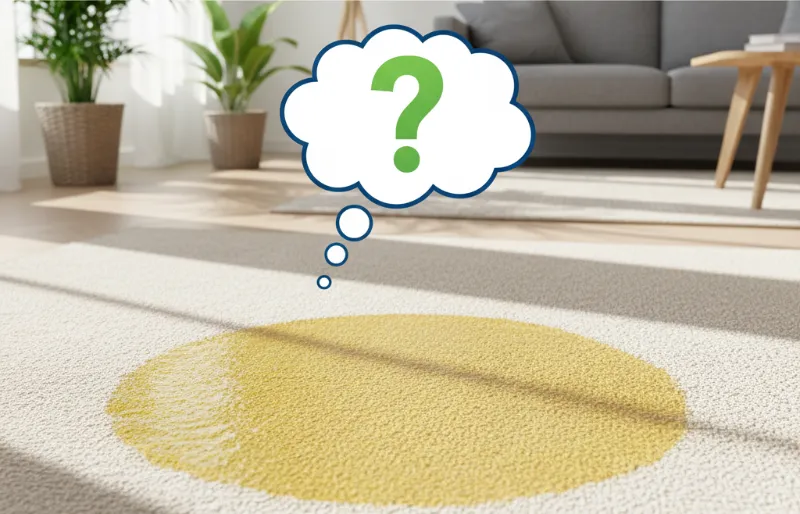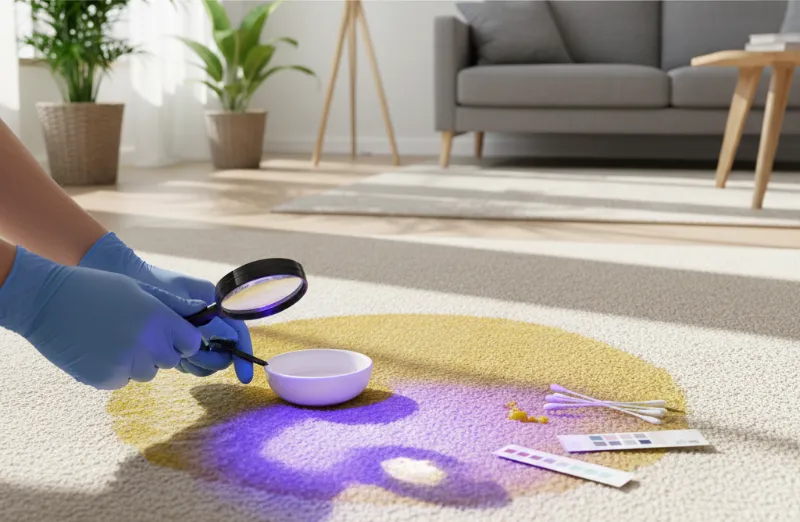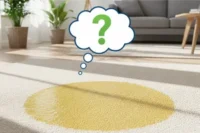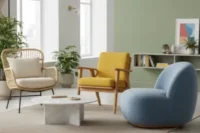Large Yellow Carpet Spots: Causes, Fixes & Prevention
Published: 3 Nov 2025
Have you ever looked at your carpet and noticed large yellow spots that seem to appear out of nowhere?
It’s a common problem that confuses many homeowners. I have seen this issue countless times.
These yellow patches can appear after cleaning, due to water leaks, or even from exposure to sunlight. They do not just make your carpet look old; they also signal something happening beneath the surface. In this article, we will explore the causes of large yellow spots on carpets, how to remove them, and how to prevent them from occurring easily.
What Are Yellow Spots on Carpets?
Yellow spots are discolored areas that appear lighter or brighter than the surrounding carpet fibers. They might look oily, dry, or slightly shiny under light. Sometimes, the spots appear suddenly after cleaning; other times, they grow slowly over weeks or months.
These stains are different from normal dirt or mud. They’re usually chemical or moisture-based, meaning something in or under the carpet is reacting with the fibers. Yellowing often happens in high-traffic zones, near windows, under furniture, or around water sources like air conditioners and plants.

1. Chemical Reactions from Cleaning Products
One of the most common causes of yellowing is a chemical reaction from cleaning products.
Many people use strong household cleaners, thinking they will “brighten” their carpets, but it often does the opposite.
Here’s why:
Most carpets are made from synthetic fibers like nylon or polyester. When these fibers come into contact with high-alkaline cleaners, bleach, or ammonia-based sprays, a chemical reaction occurs. This reaction can strip the carpet dye or change its color molecules, turning them yellow.
For example, if someone uses a laundry bleach or a “whitening cleaner” to remove a coffee stain, the area might look clean at first. But after a few days, it turns yellow or even orange. This happens because bleach removes color permanently, and sunlight or air oxidation makes the damage visible.
Tip: Always use a carpet cleaner that’s pH neutral. Look for labels that say “carpet-safe” or “approved for wool or nylon carpets.”
2. Water or Moisture Damage
Water is another major cause of yellow spots on carpets.
When carpets get wet, whether from spills, leaks, or cleaning, and do not dry properly, minerals and contaminants in the water can leave behind yellowish stains.
If you live in an area with hard water, the minerals like calcium and iron in the water can react with the carpet backing or padding underneath. Over time, this creates a yellow or brown ring.
I have seen this many times in basements, near windows, and around air conditioner units. Sometimes, the carpet looks fine on top but has yellow rings underneath because moisture got trapped between the carpet and the padding.
Real-life example:
One client in Florida had recurring yellow spots under a window. After inspection, I found a tiny leak in the frame. The moisture had been seeping in slowly for months, causing yellow rings that kept reappearing even after cleaning. Once we sealed the leak and replaced the affected padding, the issue stopped completely.
3. Sunlight and UV Exposure
Sunlight might make your room feel warm and bright, but it can also fade carpet colors.
When carpets are exposed to direct sunlight, the UV rays break down the dye in the fibers. The result? Uneven color and yellowish fading.
This happens most often in rooms with big windows or glass doors. You’ll notice that the carpet near the window looks slightly different from the rest of the floor—more yellow or faded.
Over time, sunlight can cause carpet colors to fade or change tone. Many homeowners switch to lighter shades or finishes to minimize this effect. One trending option is the distressed white style — a soft, rustic look that hides minor discoloration and blends perfectly with both modern and traditional interiors.
4. Pet Urine or Spills
Pet urine is one of the sneakiest causes of yellow stains on carpets.
At first, it might not even be visible. But as urine dries, it leaves behind salts and ammonia crystals that react with the carpet fibers. Over time, this chemical reaction causes a deep yellow or amber stain—and often, a bad odor too.
Many pet owners make the mistake of cleaning only the surface, leaving urine trapped below. When humidity rises, that old spot “comes back” to the surface, darker and more yellow than before.
Tip:
If you suspect a urine stain, shine a blacklight over the area in a dark room. Pet urine glows under UV light, helping you spot the problem zones easily. Then, use an enzyme-based pet cleaner to break down the organic compounds safely.
5. Carpet Padding or Adhesive Issues
Sometimes, the problem is not the carpet itself—it’s what’s underneath it.
Old or low-quality carpet padding can deteriorate over time. When moisture seeps into the padding, the materials inside (like foam or rubber) start to break down. This reaction can push yellow stains up through the carpet.
Also, adhesives used during carpet installation can oxidize when exposed to moisture or cleaning chemicals. That’s why you might notice perfect, round yellow spots that seem to rise from below.
If yellowing keeps returning even after cleaning, it’s likely an issue with the padding or adhesive.
Solution:
A professional inspection may be needed to lift the carpet slightly, check the underlayer, and replace any damaged padding.
6. Age and Natural Wear of Carpet Fibers
As the fibers grow old, they lose their original color and coating protection. Oxygen in the air slowly reacts with carpet dyes, especially if the carpet hasn’t been cleaned regularly. This gradual oxidation leads to fiber yellowing.
I often explain to homeowners that this process is similar to paper turning yellow with age. It’s natural and sometimes unavoidable in older carpets.
How to Identify the Source of Yellow Spots
Before trying to clean the stains, it’s important to find out what caused them. Here’s how you can do that step by step:
- Look closely: Check if the spot is circular or irregular. Chemical spots are often round, while water stains have uneven edges.
- Smell the area: A faint ammonia odor could mean pet urine.
- Touch test: Is the area stiff or crunchy? That may indicate cleaning residue.
- Check nearby areas: Look for water sources like windows, planters, or vents.
- Use a moisture meter: It helps detect hidden dampness under the carpet.

Safe Cleaning and Removal Methods
Now, let’s discuss the safe ways to remove yellow spots without damaging your carpet.
For Fresh Stains
If you catch the stain early:
- Blot it immediately with a clean white cloth.
- Mix warm water with a few drops of mild dish soap.
- Gently dab (don’t rub) the area.
- Rinse with plain water and dry completely using a fan.
For Old or Set-In Stains
For tougher stains that have been there a while, try this:
- Mix one cup of white vinegar with two cups of warm water.
- Apply lightly using a spray bottle.
- Let it sit for 10–15 minutes, then blot with a clean cloth.
- Sprinkle baking soda on the spot afterward to neutralize odor and moisture.
For stubborn stains that do not fade, a professional hot water extraction cleaning is the safest option. It removes deep residue and refreshes the carpet fibers.
What to Avoid
Never use bleach, ammonia, or any cleaner labeled “brightener.”
These products can worsen yellowing, especially on nylon or wool carpets.
How to Prevent Yellow Spots on Carpets
Prevention is always better than repair. Follow these simple habits to keep your carpet spotless:
- Vacuum regularly to remove dirt that causes discoloration.
- Clean spills immediately—don’t let them soak in.
- Use neutral-pH cleaners only.
- Keep rooms ventilated to reduce moisture buildup.
- Use dehumidifiers in humid areas like basements.
- Install UV film on windows to block harsh sunlight.
- Schedule professional carpet cleaning once a year.
These small steps protect your carpet fibers and maintain their color for years.
When to Call a Professional Carpet Technician
If you have tried cleaning but the yellow spots keep coming back, it is time to call a professional.
A certified carpet technician has the right tools to test your carpet’s pH, identify the cause, and clean it safely.
Professionals use special equipment like:
- Moisture meters for hidden leaks
- UV lights for pet stains
- Hot water extraction machines for deep cleaning
They can also re-dye small areas or neutralize chemical damage if needed.
Cost-wise, professional cleaning is far cheaper than replacing the entire carpet. And it helps restore both the look and hygiene of your flooring.
Final Tips for Carpet Care and Longevity
With regular care, a good-quality carpet can last more than 10 years without losing its beauty.
- Keep your carpet dry and clean at all times.
- Rotate furniture to prevent sunlight fading in one area.
- Use rugs or mats in high-traffic zones.
- Don’t overuse cleaning chemicals—less is more.
- Call a technician if yellow spots appear repeatedly.
With regular care, a good-quality carpet can last more than 10 years without losing its beauty.
Conclusion
Large yellow spots on carpets are more than just cosmetic—they’re signs of chemical, moisture, or environmental reactions happening beneath the surface. By understanding the causes and acting quickly, you can prevent long-term damage and keep your carpet looking fresh.
Remember: always use gentle, carpet-safe products, control moisture in your home, and schedule routine professional cleaning. A clean carpet is not just about appearance; it’s about protection.
Treat your carpet right, and it will keep your home warm, fresh, and beautiful for years to come.

- Be Respectful
- Stay Relevant
- Stay Positive
- True Feedback
- Encourage Discussion
- Avoid Spamming
- No Fake News
- Don't Copy-Paste
- No Personal Attacks

- Be Respectful
- Stay Relevant
- Stay Positive
- True Feedback
- Encourage Discussion
- Avoid Spamming
- No Fake News
- Don't Copy-Paste
- No Personal Attacks





